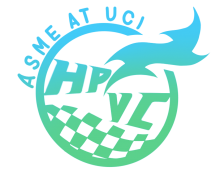Human Powered Vehicle Competition at UCI
Background
The American Society of Mechanical Engineers (ASME) hosts a competition called the e-Human Powered Vehicle Challenge (e-HPVC), where teams of students compete to design and fabricate human powered vehicles.
While the term Human Powered Vehicle (HPV) refers to any means of transportation that is powered by human muscles, ASME is actually referring to a subclass of performance vehicles that include semi-recumbent bicycles or tricycles. These vehicles are designed to be fast, safe and ergonomic. They are equipped with performance drivetrains, aerodynamic fairings and rollover-protection systems to meet these certain attributes. The e- at the front is there to represent that these vehicles also have electric motors in them. However, they are limited in power, so that the overall vehicle is still mostly human powered.
The purpose of this competition is to give growing engineers a chance to explore more environmentally minded methods of transportation, and help give them experience with design and fabrication at the same time. Most people in the U.S. get around using cars, which are very expensive and environmentally detrimental. The HPVC and e-HPVC hope to introduce an alternative method of transportation that is cheaper and less detrimental to the environment.
Goals and Objectives
The main goal of the project is to design, fabricate, assemble, and test a human-powered vehicle to compete in an endurance race. The vehicle needs to be able to maneuver around rough terrain, and also has to meet certain safety requirements, such as having a rollover protection system to protect a rider in case of the vehicle flipping over. We hope to design a vehicle that meets these requirements while also being comfortable to ride, aerodynamically efficient (through the use of a fairing), and fast enough with the electric motor to show the validity of human powered vehicles as opposed to traditional methods of transportation (cars). Our secondary goal is cultivate a growth mindset, and train students to become better engineers. We want to build off of students' eagerness to learn and give students the space to learn, grow and practice. There are plenty of technical skills to grow in during this project like computer-aided design, finite element analysis, manufacturable drawings, electrical circuits and more. Through this project our hope is not solely that students become good engineers but become confident in their engineering skills.
Requirements and Regulations
The design of the vehicle must also meet performance safety requirements detailed by the rules of the competition. The vehicle must demonstrate that it can come to a stop from a speed of 25 km/hr in a distance of 6 m. It must also have a turning radius of 8 m and demonstrate stability by moving for 30 m in a straight line at the speed of 5 to 8 km/hr. Each front wheel applied to the vehicle must contain its own brake.
The vehicle must use a rollover protection system that absorbs energy in a toppling accident. It must also prevent the body from contacting the ground as best as possible. A top load of 2670 N and a side load of 1330 N shall be applied without any indication of permanent deformation or fracture. There can be some elastic deformation, with a limit of 5.1 cm from the top load and 3.8 cm from the side load. Any permanent deformations must be attended to and fixed accordingly. The vehicle must avoid sharp edges and protrusions and all drivetrain components must contain guards.
Electrical System Requirements and Regulations
The vehicle may utilize the use of one electrical motor. It must be rated for a maximum of 500 W. The vehicle is limited to one battery with a maximum capacity of 10 Ah. The voltage on board is limited to 48 V. All electrical equipment must be properly fused and the battery must be isolated from the driver using a rigid bulkhead. Lastly, the vehicle must have an emergency shutdown system that ejects that battery. Not only is the electric motor necessary for pedal assistance during the uphill portions of the competition, this provides the opportunity for students to work with green energy vehicles. The national ASME organization understands how green energy is the future and wanted this competition to reflect the work that students may get after graduation.
Sponsors
Henry Samueli School of Engineering at UC, Irvine
- David Copp | dcopp@uci.edu
Team Contacts
American Society of Mechanical Engineers at UCI
- Project Manager (23-24) Christian Mason | masonca@uci.edu
- Operations Director (23-24) Sophia Shannon | sgshanno@uci.edu

